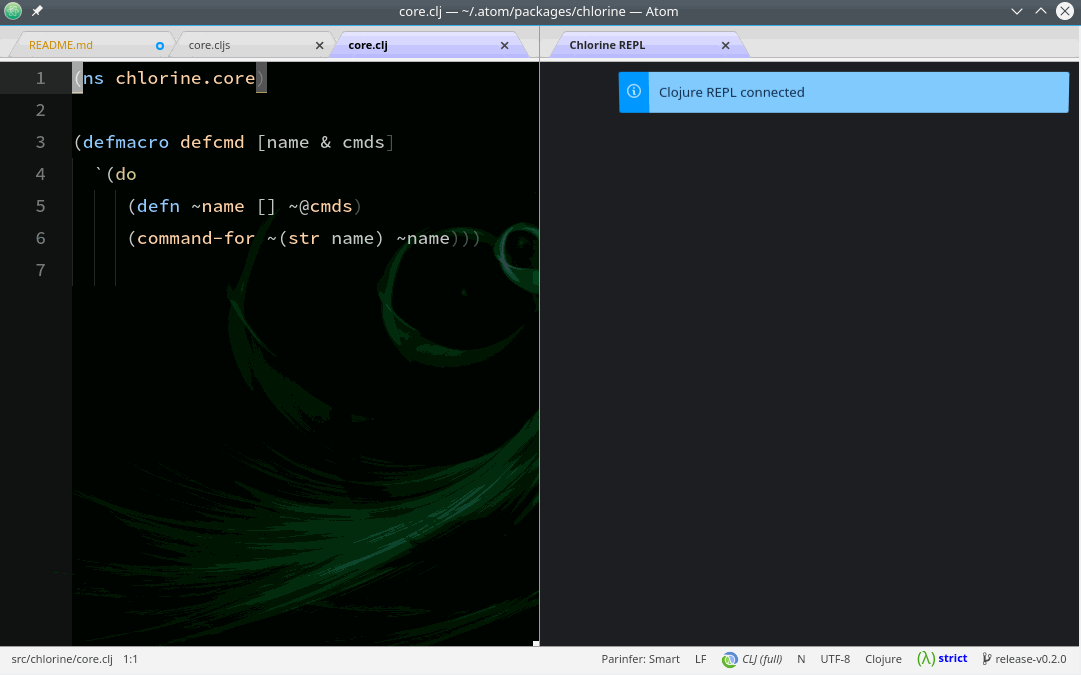mauricioszabo / Atom Chlorine
Programming Languages
Projects that are alternatives of or similar to Atom Chlorine
Cl + Atom = Chlorine
Socket-REPL integration with Clojure and ClojureScript with Atom.
This project also have a FAQ now
Example
Chlorine connects to a Socket REPL and adds autocomplete, goto var definition, evaluation, refresh, and documentation of functions on Atom. It can also add additional things, so check it out on extending Chlorine. The idea of the project is to give Atom a felling of being completely connected to running code that's being developed, like SmallTalk images but still working with textual source codes, git, and every other tool that we already use with our code.
As it is possible to see above, Chlorine works both with Clojure and ClojureScript (only shadow-cljs for now).
Usage:
If you are new to Clojure or Atom, you may check this quickstart guide.
Fire up a clojure REPL with Socket REPL support. With shadow-cljs, when you watch some build ID it'll give you a port for nREPL and Socket REPL. With lein, invoke it in a folder where you have project.clj and you can use JVM_OPTS environment variable like (on Linux or MacOS):
JVM_OPTS='-Dclojure.server.myrepl={:port,5555,:accept,clojure.core.server/repl}' lein repl
On Windows, you can add a profile on project.clj that will add these JVM options; to do it, check if your project.clj have the :profiles key. If it does, just add the :socket part, if it does not, add the :profiles tag and then the :socket:
; ... dependencies, main, etc ...
:profiles {:socket {:jvm-opts ["-Dclojure.server.myrepl={:port,5555,:accept,clojure.core.server/repl}"]}}
Then, you can run lein with-profile +socket repl, and it'll open a Socket REPL on port 5555.
On Shadow-CLJS' newer versions, when you start a build with shadow-cljs watch <some-id>, it doesn't shows the Socket REPL port on the console, but it does create a file with the port number on .shadow-cljs/socket-repl.port. You can read that file to see the port number (Chlorine currently uses this file to mark the port as default).
With clj, you can run the following from any folder:
clj -J'-Dclojure.server.repl={:port,5555,:accept,clojure.core.server/repl}'
Or have it in :aliases in deps.edn. (For an example with port 50505 see https://github.com/seancorfield/dot-clojure/blob/master/deps.edn, then you can run clj -A:socket.)
Then, you connect Chlorine with the port using the command Connect Clojure Socket REPL. This package works with lumo too, but you'll need to run Connect ClojureScript Socket REPL.
When connected, it'll try to load compliment and org.clojure/tools.namespace (for autocomplete and refresh). Then you can evaluate code on it, and it'll render on a block decoration below the line.
Keybindings:
This package does not register any keybindings to avoid keybinding conflict issues. You can define whatever you want via keymap.cson. The following have worked for some people:
If you use vim-mode-plus:
'atom-text-editor.vim-mode-plus.normal-mode[data-grammar="source clojure"]':
'g f': 'chlorine:go-to-var-definition'
'ctrl-d': 'chlorine:doc-for-var'
'space c': 'chlorine:connect-socket-repl'
'space l': 'chlorine:clear-console'
'shift-enter': 'chlorine:evaluate-block'
'ctrl-enter': 'chlorine:evaluate-top-block'
'ctrl-c': 'chlorine:break-evaluation'
'space space': 'chlorine:clear-inline-results'
'space x': 'chlorine:run-tests-in-ns'
'space t': 'chlorine:run-test-for-var'
'atom-text-editor.vim-mode-plus.insert-mode[data-grammar="source clojure"]':
'shift-enter': 'chlorine:evaluate-block'
'ctrl-enter': 'chlorine:evaluate-top-block'
If you don't use vim bindings:
'atom-text-editor[data-grammar="source clojure"]':
'ctrl-; y': 'chlorine:connect-socket-repl'
'ctrl-; e': 'chlorine:disconnect'
'ctrl-; k': 'chlorine:clear-console'
'ctrl-; f': 'chlorine:load-file'
'ctrl-; b': 'chlorine:evaluate-block'
'ctrl-; B': 'chlorine:evaluate-top-block'
'ctrl-; i': 'chlorine:inspect-block'
'ctrl-; I': 'chlorine:inspect-top-block'
'ctrl-; s': 'chlorine:evaluate-selection'
'ctrl-; c': 'chlorine:break-evaluation'
'ctrl-; S': 'chlorine:source-for-var'
'ctrl-; d': 'chlorine:doc-for-var'
'ctrl-; x': 'chlorine:run-tests-in-ns'
'ctrl-; t': 'chlorine:run-test-for-var'
How to work with ClojureScript
For now, it only works with Shadow-CLJS or ClojureScript implementations like Lumo or Plank that exposes a ClojureScript socket REPL.
With Lumo, you fire up lumo with lumo -n 3322 to start a socket REPL on port 3322 (or any other port), then connect Chlorine with "Connect ClojureScript Socket REPL".
With Shadow-CLJS, after watching (or after starting a server, or anything that starts a socket REPL) you connect with "Connect Clojure Socket REPL" (Chlorine will auto-detect the port - you don't need to change it), then run the command "Connect Embedded". Then you can run code on .cljs files too.
WARNING
Do not evaluate the
nsform in Shadow-CLJS. Shadow keeps your namespaces reloaded all the time, and sometimes re-evaluating then can lead to strange issues. If you do evaluate the ns form and get errors, just save the current file and Shadow will hot-reload it, and things will be fine. For more info, see: https://github.com/mauricioszabo/atom-chlorine/issues/213
Detection
Chlorine will try to detect the current file extension, falling back to .clj if the file is not saved. With ClojureScript, it'll only evaluate .cljs files, and it'll use the Clojure REPL to evaluate .clj and .cljc files. You can override this behavior in the package's configuration to one of the following:
- Prefer CLJ - The default configuration, will use the Clojure REPL to evaluate
.cljand.cljcand it'll use the ClojureScript REPL to evaluate.cljs - Prefer CLJS - It will use the Clojure REPL to evaluate
.cljand the ClojureScript REPL to evaluate.cljcand.cljs - CLJ - It'll use the Clojure REPL to evaluate all files
- CLJS - It'll use the ClojureScripte REPL to evaluate all files
Contributors
How to contribute?
As Chlorine is in active development, it was starting to become tedious to publish a newer version of repl-tooling for every experiment, so for now, the library is registered as a submodule. To contribute, you clone this repository and run:
./scripts/setup
To register the submodule. More info on Developing document.
Code Contributors
This project exists thanks to all the people who contribute. [Contribute].
Financial Contributors
Become a financial contributor and help us sustain our community. Contribute:
Individuals
Organizations
Support this project with your organization. Your logo will show up here with a link to your website. [Contribute]



